Our Aim
To provide you with an overview on New And existing technologies, hopefully helping you understand the changes in the technology. Together with the overviews we hope to bring topical issues to light from a series of independent reviewers saving you the time And hassle of fact finding over the web.
We will over time provide you with quality content which you can browse and subscribe to at your leisure.
TekSpek 's

AMD Radeon VII Graphics Card
Date issued:
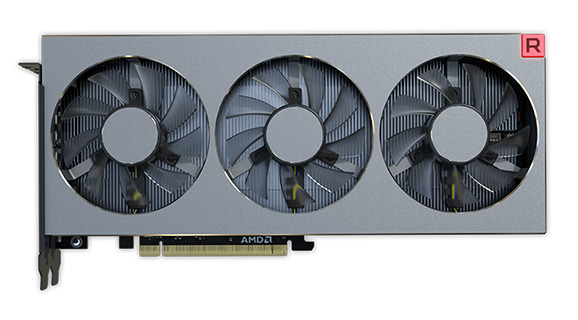
NVIDIA has commanded the high-end graphics space for quite some time, and AMD has had to play second fiddle with a fifth-generation GCN architecture, codenamed Vega, that has struggled to meet expectations.
The graphics giant's next-generation Navi architecture is still some way away, so how can AMD become a bigger thorn in NVIDIA's side in the interim? The answer is Radeon VII, the world's first gaming GPU to be built on a leading-edge 7nm process, launching today priced at $699 (£650).
Hang on, if Vega isn't quite up to the task, and Navi isn't yet ready, how has AMD managed to put together a completely new Radeon? The answer, of course, is that Radeon VII isn't entirely new. Borrowing from the enterprise space, this 7nm gaming solution uses the latest Vega architecture - GCN 5th Generation - and footprint of the deep-learning-optimised Radeon Instinct MI50 accelerator. Though manifestly powerful on the spec sheet, it is not the fullest interpretation of the Vega 20 die, because that honour belongs to the premium MI60, which trumps the 60-compute unit Radeon VII and MI50 by housing the full complement of 64 CUs.
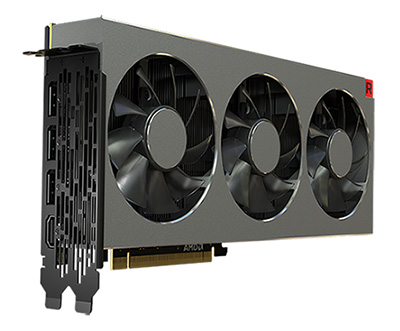
Woah, woah, woah. If Radeon VII is effectively the Instinct MI50 going by another name, how can it be made available to gamers at a fraction of the price of the enterprise card? The answer lies in a few important tweaks. Although both GPUs share a 13.2-billion transistor die, 7nm FinFET technology, an impressively small 331mm² surface area, and a 16GB HBM2 framebuffer, the MI50 can process double-precision floating-point calculations at half of SP speed, while Radeon VII can only manage 1/8th.
Think of this, then, as Instinct MI50 with key workstation features chiselled away to leave what is ultimately AMD's fastest gaming GPU to date. And there's merit to that 7nm architecture, as in addition to die-size savings, AMD is able to flex Radeon VII's clock-speed muscle, with the GPU shipping at a peak frequency of 1,800MHz. For the record, that's over 16 per cent faster than the incumbent Radeon RX Vega 64.
AMD Radeon VII: taking top spot |
||||||
|---|---|---|---|---|---|---|
| Radeon VII | Radeon RX Vega 64 | Radeon RX Vega 56 | Radeon R9 Fury X | Radeon R9 Fury | Radeon RX 580 | |
| Launch date | February 2019 | August 2017 | August 2017 | June 2015 | July 2015 | April 2017 |
| Codename | Vega 20 | Vega 10 | Vega 10 | Fiji XT | Fiji Pro | Polaris 20 XTX |
| Architecture | GCN 5th | GCN 5th | GCN 5th | GCN 3rd | GCN 3rd | GCN 4th |
| Process (nm) | 7 | 14 | 14 | 28 | 28 | 14 |
| Transistors (mn) | 13,200 | 12,500 | 12,500 | 8,900 | 8,900 | 5,700 |
| Approx Die Size (mm²) | 331 | 486 | 486 | 596 | 596 | 232 |
| Full Implementation of Die | No | Yes | No | Yes | No | Yes |
| Processors | 3,840 | 4,096 | 3,584 | 4,096 | 3,584 | 2,304 |
| Texture Units | 240 | 256 | 224 | 256 | 224 | 144 |
| ROP Units | 64 | 64 | 64 | 64 | 64 | 32 |
| Peak GPU Clock (MHz) | 1,800 | 1,546 | 1,471 | 1,050 | 1,000 | 1,340 |
| Peak GFLOPS (SP) | 13,824 | 12,665 | 10,544 | 8,602 | 7,168 | 6,175 |
| Memory Clock (MHz) | 1,000 | 945 | 800 | 500 | 500 | 8,000 |
| Memory Bus (bits) | 4,096 | 2,048 | 2,048 | 4,096 | 4,096 | 256 |
| Max Bandwidth (GB/s) | 1,024 | 484 | 410 | 512 | 512 | 256 |
| Memory Size (GB) | 16 | 8 | 8 | 4 | 4 | 8 |
| Memory Type | HBM2 | HBM2 | HBM2 | HBM | HBM | GDDR5 |
| Power Connectors | 8+8 | 8+8 | 8+8 | 8+8 | 8+8 | 6 |
| TDP (watts) | 300 | 295 | 210 | 275 | 275 | 185 |
| GFLOPS per watt | 46.1 | 42.9 | 50.2 | 31.28 | 26.06 | 33.37 |
| Launch MSRP | $699 | $499 | $399 | $649 | $549 | $229 |
Radeon VII may be AMD's most potent gaming solution, yet pushing the GCN 5th architecture to the limit will only get you so far. Although team red would no doubt like to lock horns with the best from team green, Radeon VII is positioned specifically at $699 to do battle with NVIDIA's second-rung GeForce RTX 2080.
Though the Radeon appears to have more muscle on paper - it has way more throughput and bandwidth than its immediate competitor - the GeForce has the advantage of an efficient forward-looking architecture that includes support for modern graphics technologies such as DLSS and ray-tracing.
QHD Gaming Credentials
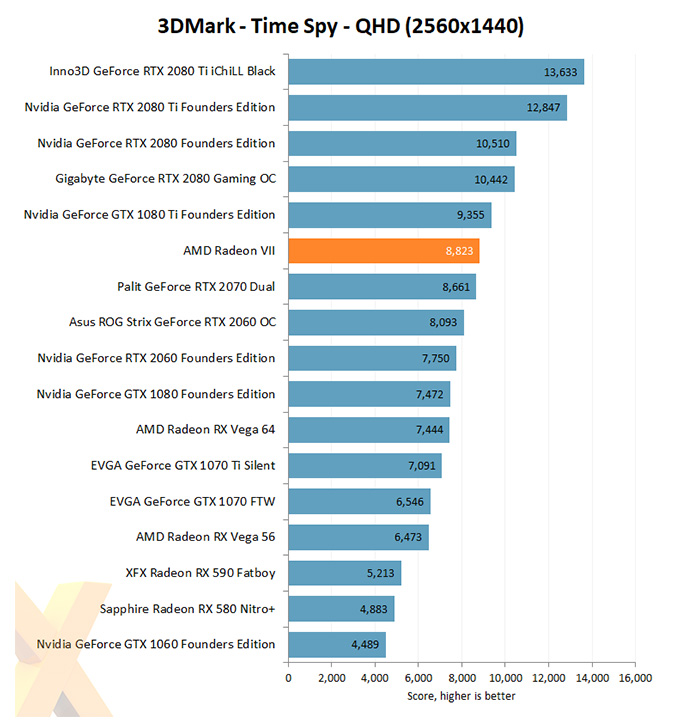
AMD's goal with the Radeon VII is to catch GeForce RTX 2080, but benchmarks from leading review sites suggest that NVIDIA continues to hold the advantage in synthetic benchmarks such as 3DMark Time Spy.
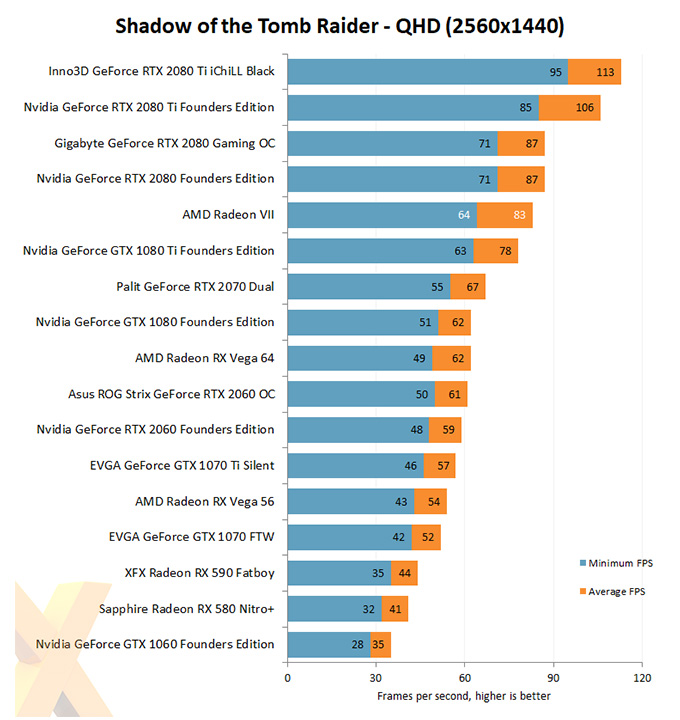
The performance gap is closer in real-world games such as Shadow of the Tomb Raider. What the performance result shows is that this is indeed AMD's best gaming offering; Radeon VII is a significant step up from Vega 64, and a fine fit for gaming at a QHD resolution.
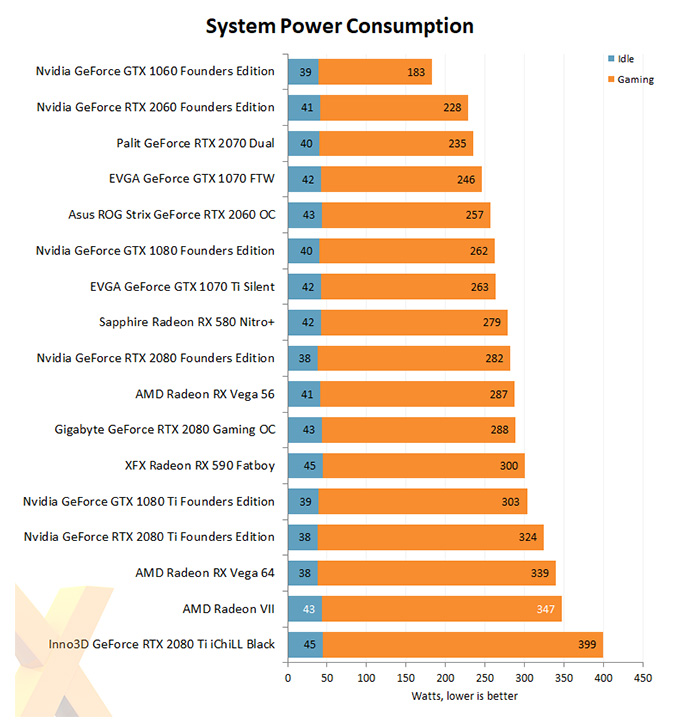
But there is a caveat to using an ageing Vega architecture in that Radeon VII simply isn't as efficient as modern challengers. System-wide power consumption is relatively high, resulting in more heat and noise than the equivalent GeForce RTX.
Summary
AMD has used a clever trick to help manoeuvre itself out of a tight spot. In order to present at least some form of threat to NVIDIA's GeForce RTX 2080, the firm has taken its Instinct MI50 compute card and shaved away some workstation-specific features to create the most powerful gaming card ever to feature the Radeon name.
Radeon VII might not be as elegant as the competition, but it packs plenty of brute strength and a huge dollop of memory, making it a viable choice for high-quality, high-resolution gaming.
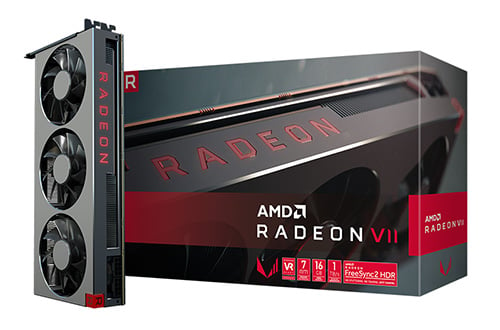
The AMD Radeon VII graphics card will, of course, be available to purchase right here at Scan on our AMD Radeon VII Graphics Card section